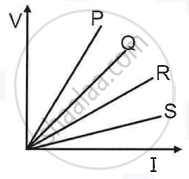Advertisements
Advertisements
प्रश्न
In the electric equipment producing heat like iron, electric heater, boiler, toaster etc., an alloy such as nichrome is used, not pure metals.
उत्तर
The performance and life of a heating element are determined by the material used to make the heating element. The heating element material must have a high melting point, high tensile strength, high resistivity, and a low-temperature coefficient of resistance. Because an alloy's resistivity is greater than that of pure metal, alloys are employed in electrical heating devices rather than pure metals. Furthermore, even at greater temperatures, the alloy does not easily burn (or oxidise).
APPEARS IN
संबंधित प्रश्न
Compute the heat generated while transferring 96000 coulomb of charge in one hour through a potential difference of 50 V.
An electric heater is connected to the 230 V mains supply. A current of 8 A flows through the heater.
(a) How much charge flows around the circuit each second?
An electric room heater draws a current of 2.4 A from the 120 V supply line. What current will this room heater draw when connected to 240 V supply line?
How does the resistance of a wire vary with its:
diameter?
An electric iron of resistance 20 ohms draws a current of 5 amperes. Calculate the heat produced in 30 seconds.
Explain why, tungsten is used for making the filaments of electric bulbs.
The current passing through a room heater has been halved. What will happen to the heat produced by it?
An electric fuse works on the:
(a) chemical effect of current
(b) magnetic effect of current
(c) lighting effect of current
(d) heating effect of current
How does the wire in the filament of a light bulb behave differently to the other wires in the circuit when the current flows?
What property of the filament wire accounts for this difference?
Two exactly similar heating resistances are connected (i) in series, and (ii) in parallel, in two different circuits, one by one. If the same current is passed through both the combinations, is more heat obtained per minute when they are connected in series or when they are connected in parallel? Give reason for your answer.
Which electric heating device in your home do you think have resistors which control the flow of electricity?
Statement 1 : Electric current ( flow of electrons ) creates heat in the resistor.
Statement 2 : Heat in the resistor is created according to the rule of energy conservation.
Explain Statement 1 with the help of Statement 2.
Name any six domestic appliances based on the heating effect of electric current.
Solve the following question.
Compute the heat generated while transferring 96000 coulombs of charge in two hours through a potential difference of 40 V.
The electricity bill specifies the usage in _______.
Find the odd one out and give its explanation.
Explain the importance/uses of fuse wire.
Define fuse.
Explain the heating effect of electric current.
An electric iron draws a current of 4 A when connected to 220 V mains. Its resistance must be:
A current of 1 A is drawn by a filament of an electric bulb. Number of electrons passing through a cross-section of the filament in 16 seconds would be roughly:
What is Joule’s heating effect? How can it be demonstrated experimentally? List its four applications in daily life.
An electric cell produces electricity from the __________ ___________ in it.
Name two electric devices for each where
(i) the heating effect of current is used and
(ii) the magnetic effect of current is used.
Your teacher has shown you the following activity.

Activity: The teacher has wound a long insulated piece of wire around an iron nail in the form of a coil. The free ends of the wire are connected to a cell through a switch as shown in Figure 14.3. The current is switched on and some pins are placed near the ends of the nail.
Write down any three questions that come to your mind about this activity
An electric fuse has a body made of ceramic and two points for connecting the fuse wire.
What is an electric fuse made up of?
What are the factors affecting heating effect of electric current?
Copper wire offers very little ______ and does not get heated up quickly.
An electric fuse is a wire made up of a material having ______ melting point.
An electrochemical cell converts ______ energy into ______ energy.
A fuse is used in an electric circuit to stop high currents flowing through the circuit.
Tara, after completing her exams, went to her grandmother's house along with her younger brother Rahul. One day, Rahul came home after playing and switched on the fan and air conditioner. At the same time, his grandmother was preparing a milkshake for him using a mixer. Suddenly, they heard a big sound and the electricity of the house got shut down. Tara is called an electrician. He said the main reason for supply to shut down was overloading.
- What is overloading?
- Is overloading and short the same? When does short-circuiting take place?
- How can the effects of overloading be avoided?
1 kWh is equal to ______.
In a set up the students coated iron nails with zinc metal and noted that, iron nails coated with zinc prevents rusting. They also observed that zinc initially acts as a physical barrier, but an extra advantage of using zinc is that it continues to prevent rusting even if the layer of zinc is damaged. Name this process of rust prevention and give any two other methods to prevent rusting.
The graph of voltage vs current for four different materials is shown below.

Which of these four materials would be used for making filament of bulb?
